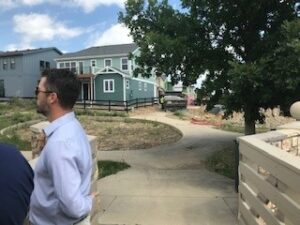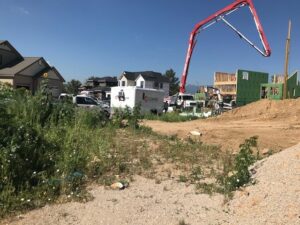The field production of Planning to Turn the Tide, the documentary film project of the American Planning Association’s Hazard Mitigation and Disaster Recovery (HMDR) Planning Division, has involved dozens of local volunteers and supporters in several states spread from Florida to California. In recent blog posts, I have been sharing our progress but not always featuring some of those volunteers. That is about to change.
Some of those volunteers were interviewed for the film because we felt that their experience and expertise supported our educational objectives for the project. Others have helped us identify people who should be interviewed, and others have led us on tours or directed us to other resources we needed to know about.
Molly Mowery, the Chair-elect of HMDR, has served as all of the above and been a great supporter. She is also the executive director of the Community Wildfire Planning Center, based in Colorado, and has spent years consulting with communities about better planning strategies to address wildfire hazards. In a recorded interview you can watch here, Molly and I discussed what we hoped to achieve in the film.
David Taylor and I had visited with Lisa Ritchie, currently the planning manager for the city of Erie, Colorado, but formerly with Louisville, and Steven Williams, the planning manager for Superior earlier in the day on Friday, July 14. Lisa and Steve took us on walking tours of areas in both Louisville and Superior where hundreds of homes had burned in what started as a grass fire on December 30, 2021, now known as the Marshall Fire. Lisa and Steve helped author a report published by the Urban Land Institute studying the causes and consequences of that fire, which has also been examined by Boulder County Emergency Management, and recommending policies and regulations.
Later that same day, David and I also recorded an early evening interview with Lori Hodges, the emergency management director for Larimer County, a vast area north of Boulder, whose largest city is Fort Collins, the home of Colorado State University. Lori provided a highly articulate argument for coordinating emergency management with comprehensive planning and other strategic county services to achieve a more holistic approach to building community resilience. She is an exemplar of a new generation of emergency managers who apply a much wider lens to their profession than has traditionally been the case. A new day of interdisciplinary collaboration in local government is dawning. It is a day I advocated more than a decade ago in the APA report, Hazard Mitigation: Integrating Best Practices into Planning. I have long believed that all communities will be better off when city planners and emergency managers, among other local officials, are meeting at the same table to find ways to make their communities safer and more resilient. People like Lori are making it happen.
If you wish to support our efforts, please use the QR code below to make a secure donation.
Jim Schwab


